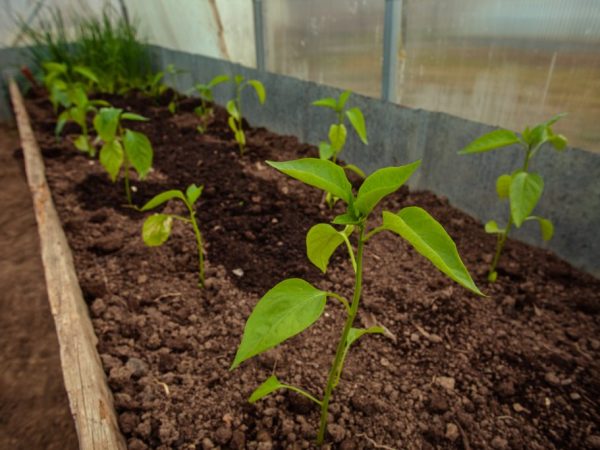All about feeding pepper after planting in a greenhouse
Pepper is a capricious culture. To get a good harvest, you must follow the rules for caring for plants. It includes fertilizing at different stages of growing, from seedlings to mature plants. Pepper feeding after planting in the greenhouse is especially important. It is necessary to accurately observe the timing of its production and carefully consider the composition of the substances used.

Top dressing of pepper after planting in the greenhouse
Features of culture
Which means to use depends on the age of the plants, the variety and the weather conditions. The main elements that are necessary for normal development:
- nitrogen - especially during the period of active growth of the stems and leaves of peppers;
- potassium - during the formation of ovaries;
- phosphorus - from transplanting to the beginning of fruiting, contributes to the development and strengthening of the root system, as a result of which the growth of plants is accelerated.
Pepper also needs magnesium, calcium, iodine, molybdenum, zinc, boron, manganese. The culture does not respond well to excess or lack of nutrients. If too much nitrogen is applied, the plants will intensively grow green mass at the expense of fruit formation.
Recommendations for the introduction of dressings
In order for top dressing to give a positive result, you should adhere to the following recommendations:
- It is necessary to dissolve mineral preparations or organic matter in warm (25 ° C) settled water. The temperature of the prepared product must match the temperature of the soil.
- Fertilizers are applied only after watering, for which a warm liquid is also taken.
- When the ground dries up a little, you need to loosen it to a shallow depth, since the root system of the peppers is superficial.
- In cloudy weather, the amount of substances that contain potassium is increased by 1/5, in sunny weather it is reduced by 1/5.
- Organic and mineral products alternate.
When to fertilize
The time for feeding peppers in the greenhouse depends on how well the bed was prepared. If compost or humus was introduced into it in the fall, and mineral fertilizers in the spring, then less nutrients will be required. In this case, they are brought in according to the following scheme:
- The first time is 14 days after planting, when flowering begins.
- The second - 14 days after the previous time during the period of ovary formation.
- The third - after collecting the first fruits.
Sometimes the bushes need additional fertilization. What types of it to use depends on the condition of the plants. If flowering does not occur, then the soil is too saturated with nitrogen. With a lack of potassium, the leaves curl up. With phosphorus starvation from below, they have a purple hue, and with nitrogen, the surface of the leaf plate acquires a matte gray color.
What fertilizers to apply
The nutrients can be absorbed by plants through the root system or through the leaves. Therefore, the methods of their introduction are different.
Root dressing

Mullein will accelerate plant development
At the first stage, poultry droppings are used, which are dissolved in water in a ratio of 1:15, insisted for 5 days.A liquid mullein-based product is also used. It is added to water in a ratio of 1:10, insisted for at least a week.
Perfect for feeding peppers in a greenhouse herbal infusion. For its preparation, take 6-7 kg of weeds. They are cleaned of roots and seeds, and crushed. Place in a barrel with a capacity of 100 liters, add 1 glass of ash and 1 bucket of mullein. Pour in water, stir. Insist for at least a week. Consumption - 1-2 liters per plant.
On the basis of mineral preparations, such a remedy is used:
- 40 g superphosphate;
- 40 g of ammonium nitrate;
- 20 g of potassium sulfate;
- 10 liters of water.
At the second stage, the following infusion is used to fertilize the peppers in the greenhouse:
- 1 glass of urea;
- 0.5 buckets of bird droppings;
- 1 bucket of last year's manure;
- 100 liters of water.
Leave for a week. Consumption of 5-6 liters of liquid for each bush. From organic matter, a mullein solution is used. The third time, the nutrients are added the same as in the second stage.
If, after feeding the peppers, an excess of nitrogen is observed in the greenhouse, then the situation can be corrected with the help of such a means: 1 tsp. potassium sulfate, 1 tbsp. l. superphosphate per 10 liters of water.
Foliar dressing
Often, after planting plants in a permanent place, foliar dressings are used to stimulate their growth. For this, 1 tsp. urea is diluted in 10 liters of water. Plants are processed. This method of introducing nutrients is also used in other cases:
- when the flowers fall non-pollinated (this happens in high temperatures) - the bushes are sprayed with a solution of boric acid: 1 tsp. for 10 liters of water;
- if the fruits are poorly formed, a superphosphate solution is used: 1 tsp. means for 5 liters of water;
- to protect against pests, as well as to increase immunity to various diseases, they are sprayed with an aqueous solution of ash.
All used liquids are filtered before use. Then it is poured into a spray bottle.
Conclusion
When feeding peppers after planting in a greenhouse, it is important to understand what types of it to use. Organic products contribute to a quick harvest, mineral - activate the growth of the crop.
In order for nutrients to give the desired effect, the rules for their introduction must be followed. The dosage of funds must be accurate, otherwise you can get the opposite result.


